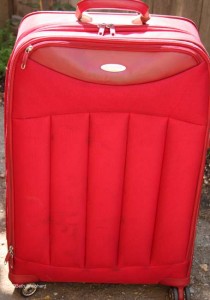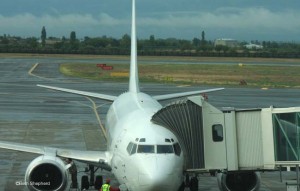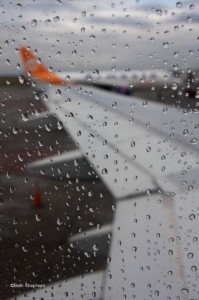 For those who follow my blog, first let me say that I’m not the one going on a trip…yet. However, enough people have asked me what I plan to bring when the moment arrives, that I decided to do a bit of research and compile a list that might be useful if you are about to embark on the exciting adventure to bring your child home.
For those who follow my blog, first let me say that I’m not the one going on a trip…yet. However, enough people have asked me what I plan to bring when the moment arrives, that I decided to do a bit of research and compile a list that might be useful if you are about to embark on the exciting adventure to bring your child home.
I remember when my sister adopted from China eleven years ago. She said she needed an entire suitcase devoted exclusively to medicine and the several thousand dollars in newly minted bills she was told to bring along, and couldn’t decide if she felt more like a bank robber or a traveling doctor. The truth is that what you will need to pack may vary considerably depending on the:
- Country you are adopting from
- Age of your adopted child(ren)
- Season/time of year (both at your destination and at your home location in the U.S.)
Traveling to Russia in the winter, for example, is going to require a lot more warm clothing for both you and your child than, say, traveling to Ethiopia in the summer. Likewise, returning from India to Seattle in the fall might necessitate light baby clothing in-country, but something warmer and more substantial when transferring planes and getting to your home once you arrive back in the U.S. If your child is an infant, bringing instant formula is essential for plane travel whereas you might pack cereal for a toddler. Diapers, a folding umbrella stroller or clothing can be easily purchased in some countries but not in others. Therefore, all the items mentioned in this post are merely suggestions. Every international adoption trip, just like every adoption, has its own customized packing list to match its unique story.
Before I launch into an itemized list (here is one of those times when I am grateful for my list-making abilities), I want to share one of the most important tips I heard regarding plane travel there and back. Make sure that any items that could be considered ‘essential’ are packed as carry on in case your luggage is lost. Murphy’s Law of adoption travel (or any air travel for that matter) stipulates that if you really need it and forget to bring it with you on the plane, your luggage will inevitably arrive late, never, or at another destination altogether.
Also, remember to leave a bit of room in your luggage for mementos you may purchase on your trip. Although you can always donate extra diapers you don’t feel you’ll need or clothes that turn out to be too big or small for your child, having a bit of ‘wiggle room’ is always a good idea.
Speaking of luggage, most international airlines have reduced the weight limit of checked baggage from 70 pounds to 50 pounds or less (for economy class) depending on the airline! Be sure to weigh your bags before you head to the airport (take them to a packing/shipping store or be brave and get on a home scale holding your luggage).
Your adoption agency may also have suggestions for items that people have found useful on previous trips. And, if not, there are a number of articles online that offer country-specific suggestions for international adoption travel.
 Documents – Take all documents in your carry-on!
Documents – Take all documents in your carry-on!
- Copy of your dossier
- Passport and visa (if required)
- Expand-a-file pocket labeled: Travel, Embassy, Forms, General info, Medical, Baby, Mementos, Language, Thank You Notes, etc.
- Money: in many countries, it is not possible to cash traveler’s checks and/or ATM machines are not available. Try to find out if there are any fees or expenses you will need cash for and budget accordingly. A money belt for carrying cash is a good idea. In some countries you will need “crisp new bills” in denominations of $20 and $50. If this is the case, call your bank to request needed cash at least two weeks before you leave. Many banks do not keep much pristine cash on hand and will need to order it for you.
- Names and phone numbers for essential in-country contacts, U.S. Embassy or Consulate Office
- Names, phone numbers and email addresses for essential stateside contacts; a neighbor , friend or family member who can access your home or wire you funds, your bank, your U.S. adoption agency, your social worker and/or attorney, international adoption doctor, insurance company, etc.
- Photograph of the translator, driver or person meeting you at the airport (though chances are they’ll have your photo from your passport)
- Electronics – Take all electronics in your carry-on
- Cell phone with SIM card that works internationally or prepaid international phone
- Camera, extra batteries, charger, flash drives for back up
- Laptop
- International converter (for international outlets and electrical service)
- Flashlight
- Video camera (optional)
- Travel Alarm Clock (everyone says the baby is a sufficient alarm clock!)
- Batteries: extras for your electronic devices as batteries can be hard to come by in some countries
Medical Supplies and toiletries – take what you can in carry-on (remember that liquids are limited to 3 oz. per item so you may need to find, or create, travel-sized amounts)
Again, note that medical conditions vary from child to child and families adopting from certain countries are more likely to experience some conditions over others.
Baby prescriptions:
- Antibiotic (in powder form which pharmacist will give you) and pre-measured distilled water to go with it (mix exactly as directed; put distilled water in checked baggage)
- Prescription cream for scabies, ringworm cream
Baby non-prescription:
- Baby Tylenol and Motrin (know beforehand under what circumstances you would choose either to use)
- Lotrimin AF for diaper yeast infection (the tube will say it’s for athlete’s foot, and it is, but it’s a non-prescription antifungal recommended by pediatricians)
- Hydrocortisone cream (half or one percent) for rashes
- Pedialyte replacement for diarrhea (there is a powdered brand that you can reconstitute called Kaolectrolyte
- Lice shampoo and comb (pack in checked baggage)
- Pediatric cough syrup
- Thermometer
- Oragel
- Glycerin suppositories for constipation in infants
- Nail clipper
- Nose syringe
- Syringe-type dropper or medicine spoon
- Baby wipes
- Baby shampoo and lotion (pack in checked baggage)
- Diaper Rash Cream
- Playtex bottles with drop-in, disposable BPA-free liners (no need to wash bottles, just nipples), and several nipple of various speeds. Remember the water will likely not be safe to drink so you will be using bottled water to make bottles.
- Diapers: At least 5-7/day; you might be able to diapers get in-country but it’s still a good idea to carry some as disposable diapers bought in other countries are often not as good quality as in the U.S. Often new babies have diarrhea and go through many diapers per day.
- Formula: Chances are you will be able to buy baby formula in your child’s country, the type he is accustomed to; but, you may also want to pack a little of your own.
- Electric hot pot or heating element to boil water (tea for adults or instant soup) or to sterilize nipples for baby bottle
- Plastic tongs for retrieving baby bottle nipples from boiling water
Adults for carry-on:
- Regular prescriptions for the adults traveling plus Cipro for each adult
- Non-prescription for adults: Neosporin, Baindaids, Immodium, Pepto-Bismal, Nyquil/Dayquil, Mylicon, Mucinex D, Eyedrops
- Pain medication for adults: Tylenol, Excedrin, Aspirin, Ibuprofen (whichever you favor)
- Benadryl and or Zyrtec for allergies
- Earplugs and/or eye shade
- Lotion (small bottle): bring a baby lotion that can be used for both adults and your child
- Tissues/Kleenex
- Travel toilet paper
- Cleansing cloths with soap (Ponds, etc.)
- Hand Sanitizer
- Toothbrush/toothpaste
- Contacts, saline solution (travel size)
- Glasses (and sunglasses)
- Lipbalm
- Plastic bags (Ziploc) in a few different sizes (even a couple grocery bag size): plastic bags are so useful for many things, like the clothes that end up with baby puke on them at 30,000 feet
Toiletries for checked baggage (or preferably travel sizes for carry-on)
- Travel Shampoo/ Conditioner
- Brush and/or comb
- Hair clips/headband/pony tail holders (something to get hair out of face)
- Make Up
- Soap/ body wash
- Sunscreen
- 1 extra towel (light weight absorbent towel)
Adult clothing
Note: Choose clothing that that is in neutral colors and goes together. Clothes that you can layer and un-layer that are light-weight, non-wrinkling and dry quickly are best. Many countries have laundry service or you can pack a Ziploc baggie with laundry detergent and either roll wet, clean clothes in a towel to dry or bring a short line of twine for a clothing line.
One article I read on packing light for travel, suggested limiting yourself to 25 articles of clothing (including underwear!). Make sure that every item you bring can be worn at least twice and goes with most of the other clothing you bring.
- 1 pair of closed-toe, comfortable shoes to wear that are good for walking
- If hot weather, one pair comfortable flip-flop/sandals
- 3 shirts (sleeve length and material depending on weather): of course if you sweat more, you might take more shirts and less pants/skirts
- 3 pants and/or skirts (depending on your gender and your style preference)
- Sweater or light jacket (or sweater plus heavier jacket if cold climate/winter season – many countries do not have central air or heat)
- Hat (to block sun etc.)
- 1 hanging around the room outfit (e.g. sweats or lightweight pants, t-shirt, hoodie)
- Socks
- Something to sleep in
- Underwear for one week
- Raincoat
- One “nice” outfit for court dates
For women: a colorful pashmina or other large scarf can dress up an outfit and be used as a wrap, or shawl and even double as a pillow. Bring only inexpensive, low maintenance jewelry (e.g. earrings that cannot be pulled out of your ears by a curious baby). Check out this Wanderlust and Lipstick article on ‘Packing tips for women travelers.‘
Important! Take one change of clothes in your carry-on. I can’t tell you how many times I’ve heard parents tell of bringing a change of clothing onto the plane for the baby if she poops/pukes, but not for themselves if said baby poops/pukes on mama…or if luggage is lost.
NOTE: Clothing numbers are based on five to seven day in-country stay. Consider carrying a few different sizes if you don’t know accurate size/weight of your child…you can always donate what you don’t need to the orphanage. Knits and elastic waist items that will wash and dry easily, if needed.
It’s also nice to bring a few gifts for in-country staff (pack in checked baggage): orphanage staff, translator, host, attorney and driver. We like the idea of gifts with “local flavor” – as Seattleites we might bring chocolate bars from Seattle’s ‘Theo Chocolate,’ ferry boat ornaments, smoked salmon and postcards with pictures of the Pacific Northwest.
**Take approximately half the clothing listed below in your carry-on**
- 8 outfits
- 8 pjs
- Socks –several pairs
- 1 pair of shoes
- 5 Bibs
- 3 knitted caps
- 5 burp cloths
- 2 blankets
- 1 crib sheet
- Age appropriate toys (2 rattles, soft book, 2 teething toys): take one each in carry-on
- Baby Bjorn, sling (if small infant) or baby carrier of your choice
- Head to Toe Fleece Outfit (might only be necessary when landing landed back in the US and needing to switch terminals at then get to our car when home; and, weather depending)
- 2 Sleep sacks (take just one in carry-on)
- Pacifiers (2 different types)
- Baby towel
- Umbrella stroller (depending on country, can be purchased in country)
- Pac ‘n Play (one more thing to carry on, but I have heard several adoptive families say that it was valuable when they traveled…again, depending on distance and time to travel home).
For older child
- Age-appropriate toys (maybe something soft and cushy for carry on that would double as a pillow)
- Clothes – several changes
- Pull-up training underpants…just in case
- Picture book with photos of “new home”
- Picture ‘Point Book’ (travel book with photos of just about everything – we have one called “Point It: Traveler’s language Kit”) – great to point at what you’re trying to talk about if you don’t know the language (works with adults too!)
- Arrange for someone to explain – pre-flight – what they can expect/what is going to happen
Additional Carry-on Items
- A few protein or oatmeal bars or other airline-friendly snacks. Bring a few meals worth of comfort food for times you may not feel like leaving your room with your new child. Cup a soup, instant oatmeal, chocolate, granola bars, cheese crackers, beef jerky, and dried fruit are all good choices. Don’t forget a bowl and spoon for your in-room meal!
- Water (purchased after security check)
- Deck of Cards or travel game (for adults)
- Books and/or magazines: Everyone says they tend to bring more than they need (e.g. one)
- One in-country guide/travel book (or relevant pages torn out/printed)
- Notebook/Journal and pen
Whew! Well, I’m sure this list – while exhausting – is not exhaustive. Adapt, as needed, and if you’re about to jet off and pick up your kiddo:
BON VOYAGE…and Congratulations!!

WOW — thank you thank you thank you Beth, this is wonderful!!!!
Glad it’s helpful…can’t wait to use it myself 😉
Hope you can soon! Also, I vote for Ergo carrier. Are you guys planning on a homecoming trip (someday, sigh) with a lap baby or buying baby a seat? With the seat you have to bring a car seat/stroller rather than umbrella stroller… hmmm….
I’ve heard that the carriers (Baby Bjorn, Ergo…etc.) are all pretty individual and some fit better with one size person (adult not infant) than another. We’re still waiting for a referral so the decisions are a ways off for us, but lap vs. buying a seat might somewhat depend on how old the kiddo is at homecoming. I’ve heard some airlines have baby bassinet/sleepers you can “reserve.” I would probably stash a car seat at our home airport (or in the car of whomever picks us up)…might not even use an umbrella stroller depending on the kid’s age…haven not checked into car seat/stroller options yet.
Excellent ideas!!!
Please consider buying some of the items while in Armenia to help with their economy.
Absolutely, Theresa! Got lots of wonderful mementos for ourselves, family, friends and child-to-be last trip and plan to do the same when we go again once we receive our referral.